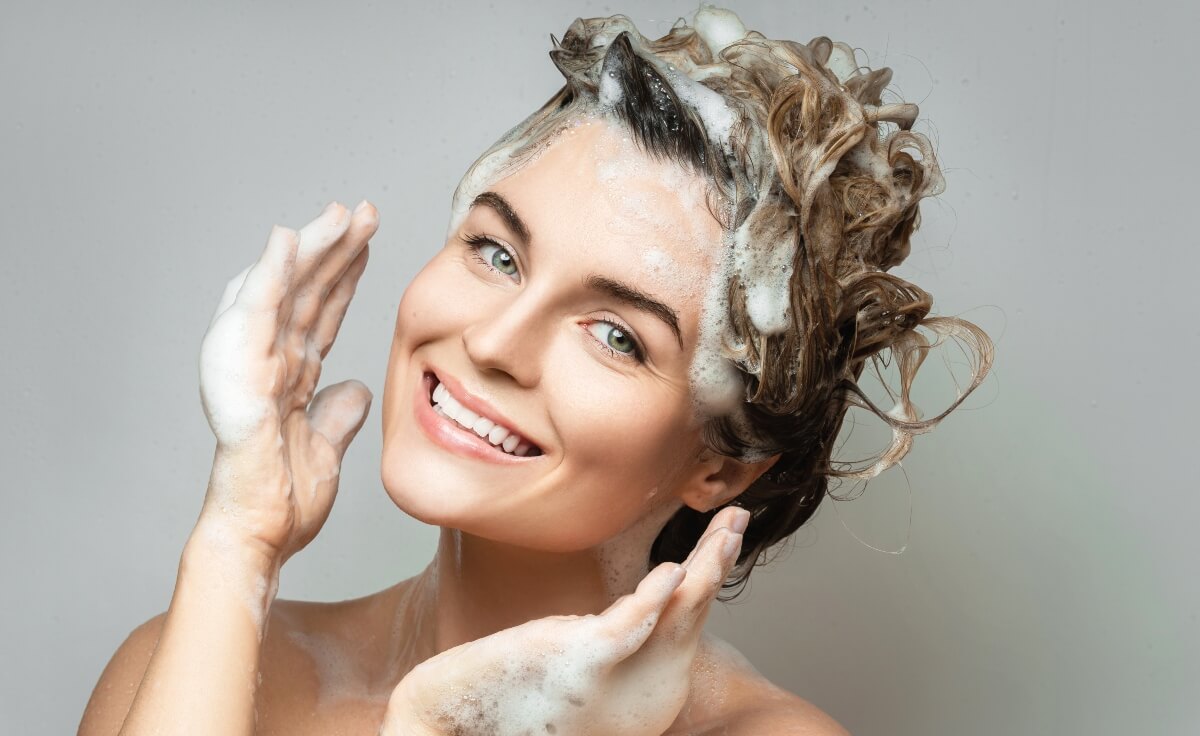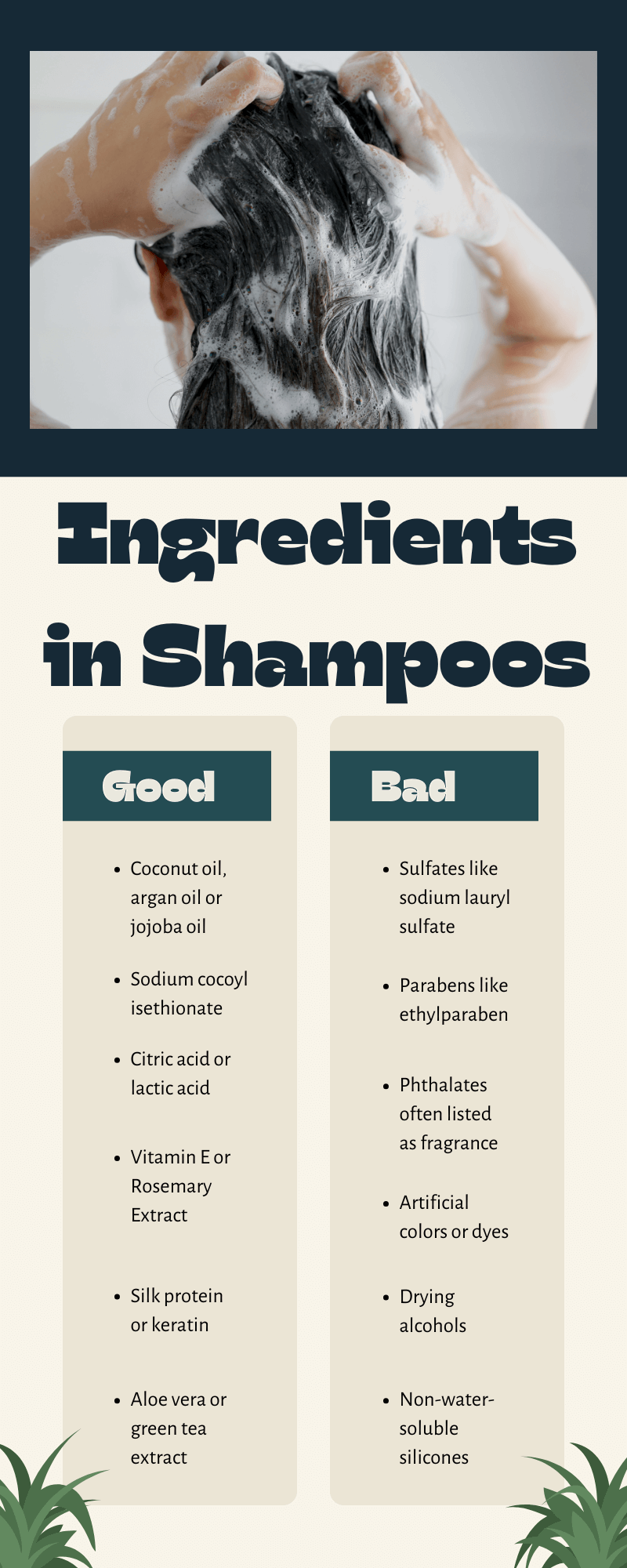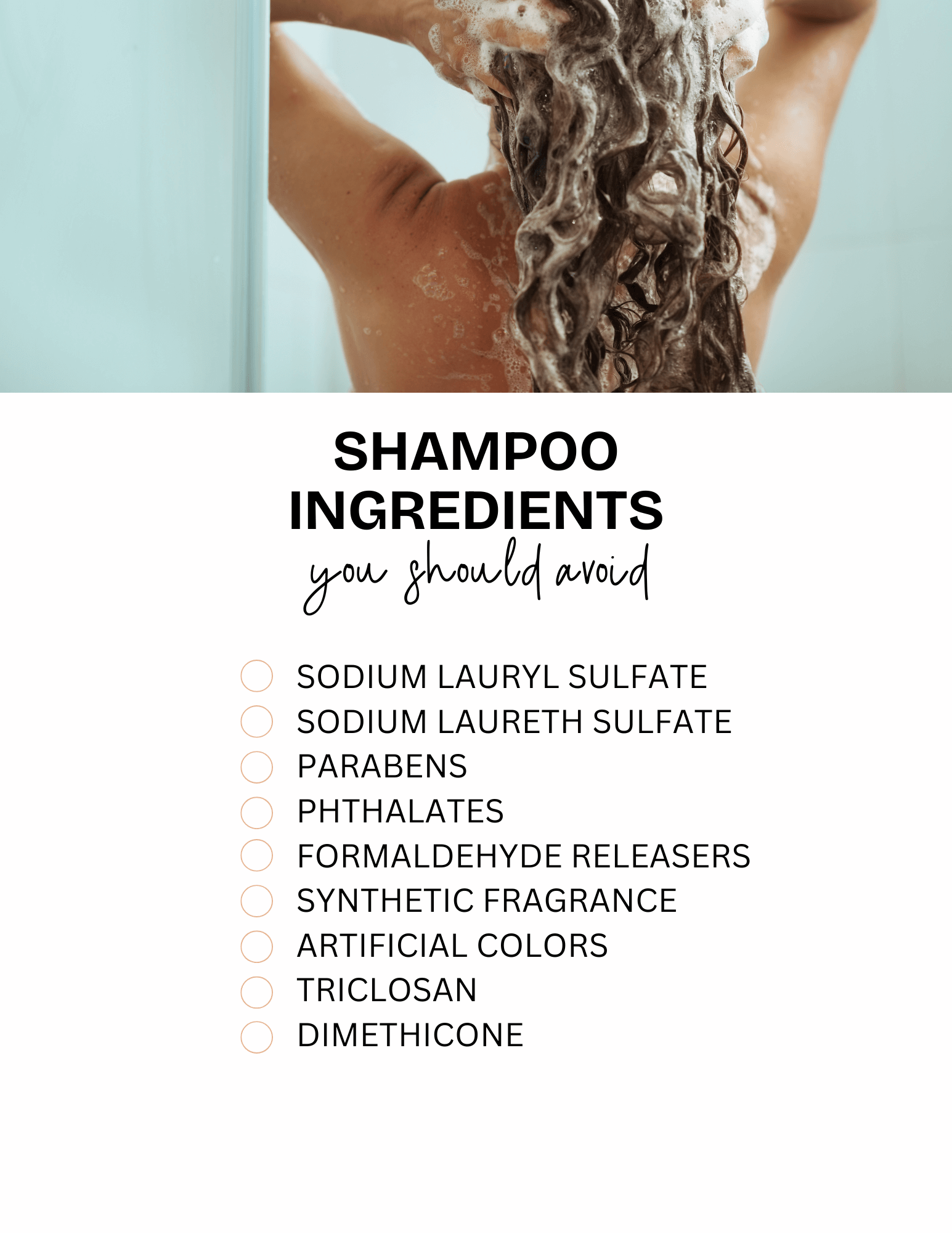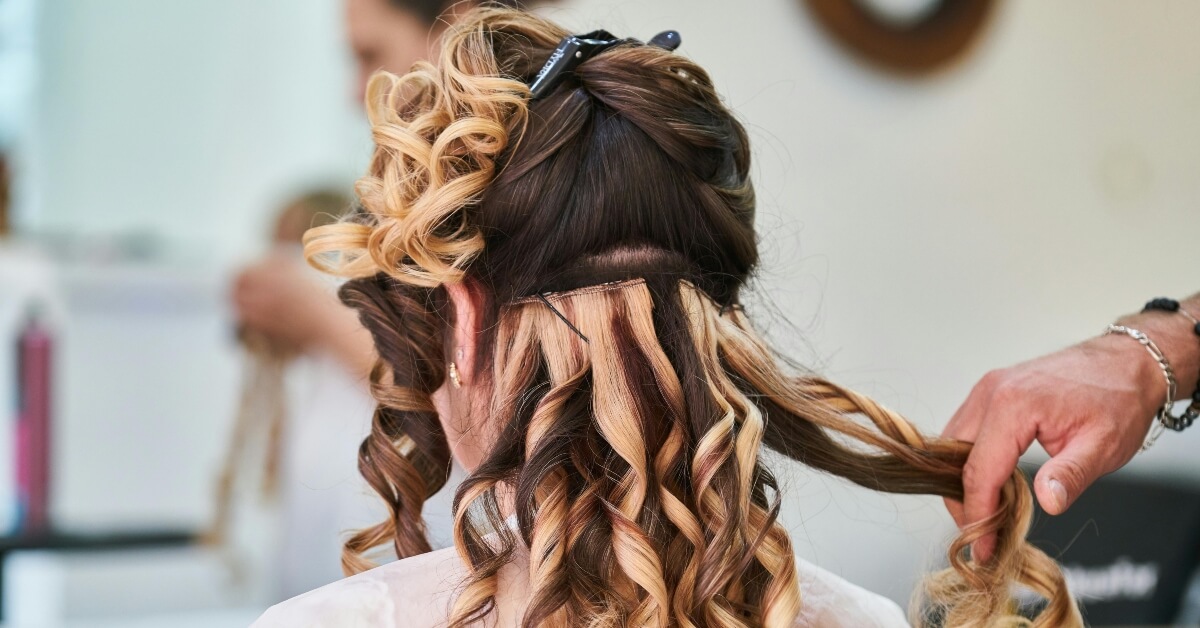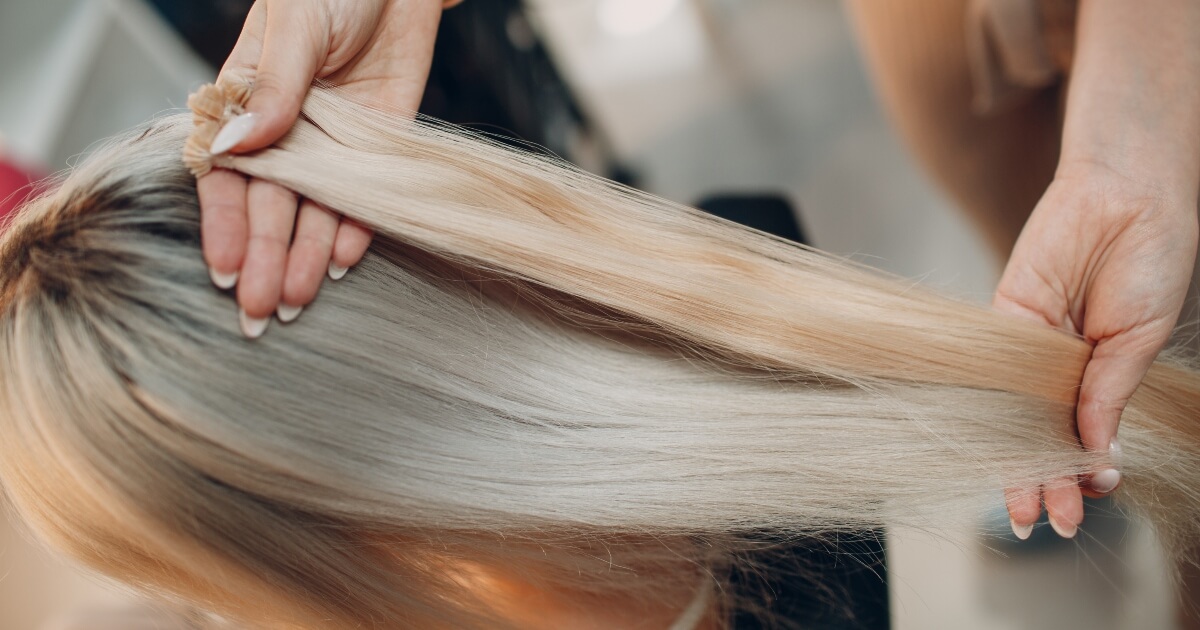Quick Reference Guide: Shampoo Ingredients
Ingredients to Avoid
Sulfates
- Sodium Lauryl Sulfate (SLS)
- Ammonium Lauryl Sulfate
- Sodium Laureth Sulfate (SLES)
Hormone-Disrupting Preservatives
- Parabens (methylparaben, propylparaben, butylparaben, ethylparaben)
- Phthalates (often hidden under “fragrance”)
- Formaldehyde-releasing agents (DMDM hydantoin, imidazolidinyl urea, quaternium-15)
Synthetic Additives
- Synthetic fragrances (containing up to 3,000+ chemicals)
- Artificial colors (FD&C and D&C dyes)
- Triclosan
Build-Up Creators
- Dimethicone (non-water-soluble silicone)
- Cyclomethicone (non-water-soluble silicone)
Other Harmful Ingredients
- Retinyl palmitate
- Diethanolamine (DEA), MEA, TEA
- Drying alcohols (denatured alcohol, isopropyl alcohol, ethanol)
- Sodium chloride (especially problematic for color-treated hair)
Healthy Ingredients to Look For
Gentle Cleansers
- Sodium Cocoyl Isethionate (coconut-derived)
- Coco-Glucoside (sugar-based)
- Decyl Glucoside (sugar-based)
- Shikakai (natural soap pod)
- Soapnuts
- Bentonite clay
- Rhassoul clay
Nourishing Proteins
- Hydrolyzed quinoa protein
- Silk protein
- Keratin (from sheep’s wool)
Beneficial Oils
- Coconut oil (penetrates hair shaft)
- Argan oil (rich in vitamin E and fatty acids)
- Jojoba oil (mimics natural sebum)
Plant Extracts & Natural Actives
- Aloe vera (soothes scalp, adds moisture)
- Green tea extract (antioxidant protection)
- Chamomile extract (natural lightening, adds shine)
- Rosemary extract (promotes hair growth)
Smart Conditioning Agents
- Cetyl alcohol (fatty alcohol – moisturizing)
- Stearyl alcohol (fatty alcohol – smoothing)
- Cetearyl alcohol (fatty alcohol – conditioning)
- Panthenol (pro-vitamin B5)
- Sodium PCA (natural moisturizing factor)
- Glycerin (humectant when used properly)
pH Balancers
- Citric acid
- Lactic acid
Natural Preservatives
- Rosemary extract
- Vitamin E
- Essential oils (instead of synthetic fragrances)
We are often unaware of harmful ingredients in the products we regularly use, like shampoos and conditioners.
Unfortunately, these ingredients could sabotage all your effort to have the hair you want. In this blog, we explore some of the many problematic ingredients in shampoos and conditioners, explaining how they can damage your hair. We also discuss ingredients that you should look for when purchasing shampoo.
If you need more advice from experts on hair care, Societe Salon is here to help. Our stylists are not only committed to delivering the amazing haircut, extensions and color you are looking for. We also explain what our clients can do to help manage their hair at home.
Book your appointment today with one of our elite stylists.
Why Your Shampoo Bottle Might Be Sabotaging Your Hair Goals
You might think you’re doing everything right. You’re shelling out big bucks on expensive treatments, using heat protectant religiously, and never sleeping with damp hair. But your hair is getting more dry and brittle.
And what’s the problem? The same shampoo that you depended on to clean and protect your hair could be doing the opposite.
Here’s something that will blow you away: the average woman exposes her body to over 160 different chemicals every single day using personal care products. Your shampoo alone may contain 15-30 of those chemicals that:
- Have probably never been tested for long-term safety
- Strip away natural oils from your hair
- Disrupt your hormone levels
- Penetrate into your bloodstream through your scalp
The beauty industry does not need to prove these ingredients are safe before adding them to products you use daily. They rely on safety data from decades ago or ingredients that are “generally recognized as safe”, even when newer studies suggest otherwise.
But here’s the empowering part:
Once you understand what to watch out for, you’re able to make intelligent choices that transform your hair health. This is not about throwing everything away. It’s understanding what’s really in your products and implementing subtle changes.
Along the way, you’ll discover just which ingredients are doing more harm than good, why they continue to sit on the shelves in spite of that reality, and maybe most importantly, what to substitute them with.
You’ll learn how to read labels like a pro, make the switch to cleaner product without breaking the bank, and create a hair care system that nourishes your hair from root to tip.
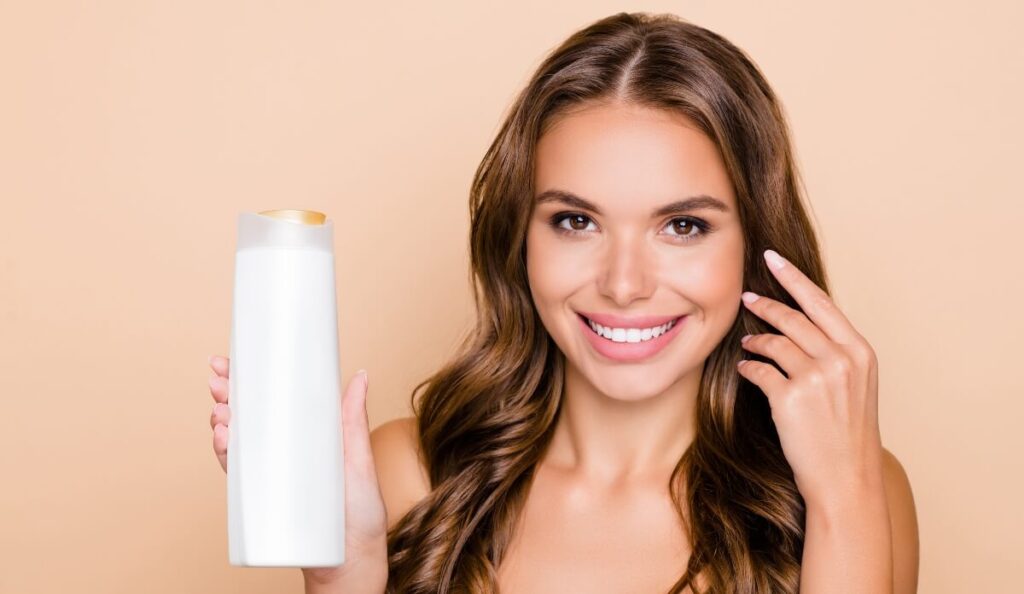
The Hidden Health Crisis: How Harmful Shampoo Ingredients Affect Your Body
We all think of shampoo as being something left on the surface – we lather, rinse, and assume it’s down the drain. Your scalp isn’t sitting there idly, though. It’s one of the most absorbent areas on your whole body, and what you put on it doesn’t make it down the drain.
The Scalp Absorption Factor
Your scalp skin is a lot more permeable than your arms or legs skin. Think of it – this is where your hair follicles create little channels that go directly into your blood system. Each follicle is essentially a direct route through your skin’s protection barrier.
- When you massage shampoo into your head, you’re not just cleaning your hair. You’re potentially injecting chemicals straight into your bloodstream.
- Scientists have found that some of the chemicals in shampoo can be found in blood samples in minutes of use. That is particularly concerning when you consider most of us wash our hair daily or every other day.
- Your scalp is also hotter than the rest of your body, and the warmer sites absorb more.
- You’re also massaging shampoo in (which makes more blood flow and opens pores). These create the perfect conditions for chemicals to be absorbed into your body.
What makes this even more problematic is that many shampoo ingredients are designed to penetrate. Surfactants, for example, are specifically formulated to break down barriers – that’s how they clean. But they don’t discriminate between the barriers on your hair and the protective barriers of your skin.
Cumulative Chemical Load
The problem with some chemicals in shampoos is they accumulate over months and years.
Your liver works day and night processing and flushing toxins from your body. But when you expose yourself to the same offending ingredients every day, your own detoxification processes can be bogged down. This can cause your body to become more sensitive to products you’ve used for years, like your favorite shampoo.
Unlike hair or face products that you would skip on the weekends, most women wash their hair 3-4 times a week. A year goes by and that’s 150+ times we’re exposed to the exact same ingredients.
Ten years? We’re talking about 1,500+ exposures to ingredients that were never tested for long-term safety at such a frequency.
Research is starting to show connections between certain shampoo ingredients and:
- Hormone disruption
- Reproductive issues
- And some cancers
We can’t say “this shampoo gave me this health problem,” precisely, but the information is so questionable that many countries have started prohibiting or restricting chemicals still allowed in US products.
The good news is that your body is incredibly resilient. By reducing your exposure to offending ingredients, your in-built detoxing processes can start to catch up and restore their health. In fact, this can happen in a matter of weeks.
The Ultimate Ingredient Blacklist: 15 Chemicals to Avoid at All Costs
Let’s get real about what you’re actually looking for – and trying to avoid – on ingredient lists. These aren’t merely “not so great” ingredients. These are chemicals with established problems that actually hinder your hair health goals.
The Sulfate Family (More Than Just SLS)
Everyone’s heard that sulfates are “bad,” but they don’t really know why and aren’t aware there are quite a few different types masquerading in products.
Sodium Lauryl Sulfate (SLS)
This is one of the most well-known perpetrators. It’s the chemical that creates that nice lather we’re conditioned to associate with being “clean.” But SLS is so harsh that it’s actually used in clinical trials as an irritant to the skin – researchers apply it deliberately to induce inflammation of the skin so they can observe healing treatment.
When you regularly apply SLS to your scalp, you’re essentially causing low-grade inflammation with each shampooing. That inflammation can make you itch and flake, but over time is actually harmful to the hair follicles themselves.
Ammonium Lauryl Sulfate
This is also marketed as a “gentler” alternative to SLS, but really, it’s not much different. It’s just a bit less irritating, but still strips your natural oils from your hair and creates the same long-term problems.
Sodium Laureth Sulfate (SLES)
This is another “softer” alternative that’s still not good. SLES undergoes a treatment known as ethoxylation, which creates a carcinogenic byproduct known as 1,4-dioxane. Manufacturers do not need to list 1,4-dioxane on products under the FDA, since it is a byproduct, not a part of an ingredient. So you might be unknowingly exposing yourself to a proven carcinogen.
All these sulfates break down that lipid layer shielding your hair shaft. Your hair becomes more porous, leading to faster moisture loss and is typically damaged by UV light, hot weather, or chemical treatment.
Hormone-Disrupting Preservatives
This is most likely the most deplorable collection of ingredients in personal care products, as they are not only harming your hair, but your whole endocrine system.
Parabens (methylparaben, propylparaben, butylparaben, ethylparaben) are preservatives that prevent bacteria and mold from growing in a product. They’re great at it, so they’re used in approximately 85% of personal care products. The problem is parabens mimic estrogen within your body.
Research has discovered parabens in breast cancer tissue, but researchers can’t conclude the parabens necessarily caused the tumors. What we do know is that parabens have the potential to throw off your own natural hormone balance, and this can have an impact on everything from your menstrual cycle to your hair growth cycles.
Phthalates are disguised in products as the generic term “fragrance.” They’re put in to help fragrances last longer and to help other ingredients penetrate your skin more easily. Phthalates are endocrine disruptors that have been linked to reproductive issues, precocious puberty in girls, and lower fertility.
Formaldehyde and formaldehyde-releasing substances are used as preservatives, while formaldehyde itself is a carcinogen. You won’t often see “formaldehyde” on a label – instead, look for ingredients like DMDM hydantoin, imidazolidinyl urea, or quaternium-15. These emit formaldehyde slowly over time to keep the product fresh.
Synthetic Additives That Damage
Synthetic fragrances are also one of the biggest wildcards among personal care products. The term “fragrance” is acceptable to describe a blend of over 3,000 different chemicals, and manufacturers don’t have to disclose what chemicals they contain exactly because fragrance formulations are classified as “trade secrets.”
Most of these hidden chemicals are:
- Known allergens that trigger skin reactions
- Hormone disruptors that affect your endocrine system
- Respiratory irritants that cause headaches and breathing issues.
If you’ve ever had a headache from someone’s pungent shampoo smell, then you’ve felt the effects firsthand of how these artificial fragrances can impact your body.
Artificial coloring (FD&C and D&C dyes) has no use in shampoo for any reason other than to make it appealing. A majority of such dyes are petroleum-based and have been connected with skin irritation and allergic response. Some research even implicated connections with behavioral disorders among children.
Triclosan is antimicrobial and was actually banned for use in hand soaps in 2016 due to safety concerns but continues to be used in other personal care products. Triclosan is a thyroid function disruptor and is also a cause of antibiotic resistance.
Silicones and Build-Up Creators
The most popular silicones used in hair products are dimethicone and cyclomethicone. They’re applied to provide that smooth, silky feel and calm the frizz temporarily. The catch with most silicones is that they’re not water-soluble, so they layer up on your hair shaft over time.
This accumulation creates a layer that prevents moisture and nourishment from seeping into your hair. Your hair might be smooth at first, but it will ultimately be dull, heavy, and prone to breakage. The sole means of removing silicone buildup is with abrasive sulfates, which creates a cycle of stripping and coating your hair.
Some silicones are water-soluble and won’t accumulate, but the majority of products include the non-soluble ones since they are cheaper and create more dramatic short-term effects.
Lesser-Known Culprits
Retinyl palmitate is just one form of vitamin A that is occasionally found in shampoos due to its supposed anti-aging properties. Yet when retinyl palmitate is exposed to sunlight (and that happens every time you go outside after shampooing), it actually hastens skin damage and increases risk for cancer.
Diethanolamine (DEA) and related chemicals like MEA and TEA are used to create foam and regulate pH. DEA can react with other formula ingredients to form nitrosamines, proven carcinogens. DEA is banned in cosmetics in the European Union, but not in the United States.
Dehydrating alcohols like denatured alcohol, isopropyl alcohol, and ethanol differ from the healthy fatty alcohols that you’ll learn about later. They’re quick-evaporating, short-chain alcohols that dry out your hair by evaporating wetness in the process. They’re typical in oily-haired individuals’ products but really add to the problem by making your scalp produce excess oil.
Sodium chloride, or table salt, is used as a thickener in the majority of shampoos, especially sulfate-free ones. Salt itself is not necessarily harmful, but it can be extremely drying to your scalp and hair, especially if you color or chemically treat your hair.
Special Considerations: Ingredients to Avoid Based on Your Unique Situation
Not everyone of us needs to avoid all potentially irritating ingredients at the same speed. Depending on your life cycle, hair type, and scalp health, some ingredients will be more of a problem for you than others.
Pregnancy and Nursing Safety
If you are pregnant or lactating, your blacklist of ingredients is even shorter. Some chemicals can cross the placental barrier and affect your developing baby, and other chemicals appear in breast milk.
High-priority ingredients to steer clear of during pregnancy: Parabens are especially troubling during pregnancy because they can disrupt your body’s normal hormone balance at a time when hormonal equilibrium is most important. Parabens have been detected in cord blood and amniotic fluid, so clearly, they’re making their way to your baby.
Phthalates are also an issue. Exposure to phthalates prenatally has been shown to cause developmental and reproductive problems in children. Since phthalates are often hidden under the label “fragrance,” it’s best to avoid artificially scented products entirely during pregnancy and lactation.
Avoid formaldehyde-releasing preservatives too because formaldehyde is suspected to be a human carcinogen, and you don’t want any exposure at this time.
Safe alternatives during pregnancy: Utilize products scented with essential oils instead of synthetic fragrances, and utilize products that are naturally preserved by ingredients such as rosemary extract or vitamin E. Certain brands now make pregnancy-safe product lines that eliminate all of the ingredients that may be suspect.
Hair Type-Specific Problems
- Textured and curly hair is naturally weaker than straight hair because of its curl shape. Each bend in a curl is a weak point where the hair can break. This means that harsh surfactants like sulfates are particularly worst for curly hair.
- Curly hair is also dry because the natural oils of your scalp find it easier to reach the curved hair shaft. Dry alcohols and abrasive detergents in products can exacerbate this dryness and breakage and frizz.
- Thin hair is another example. Thin hair weighs light easily, but it also oils more quickly, so you may find yourself using harsher cleansers to wash it. The trick is to seek out gentle cleansers that will not remove everything from your hair but will not leave any residue behind either. Silicones are a special problem for fine hair because even small amounts of buildup cause your hair to look limp and greasy. Use water-soluble silicones or eliminate them altogether.
- Color-treated hair has been chemically processed, so it’s more porous and delicate. Sulfates are especially destructive to color-treated hair because they can break down the color molecules out of your hair shaft.
- Salt (sodium chloride) is another one to avoid if you color your hair because it will deplete your color faster and dry your hair out causing it to become brittle.
Scalp Conditions and Sensitivities
If you suffer from eczema, dermatitis, or other inflammatory scalp disorders, you need to be especially careful about irritants. Sulfates, fragrance nasties, and preservatives like methylisothiazolinone can all induce flare-ups.
Psoriasis patients should stay away from any product that will cause irritation or disrupt the skin barrier. Some ingredients to avoid are sulfates, drying alcohols, and fragrance. Silicones can also help trap dead skin cells and spread flaking for some psoriasis patients.
Rosacea can also travel up onto your scalp, and a lot of typical shampooing ingredients can be causes of flare-ups. Steer clear of alcohols, strongly scented products, and vasodilation-causing ingredients because these can make the redness worse.
The key to all scalp sensitivity is to introduce new products slowly and keep a diary of what you have tried and how your scalp reacts. This allows you to identify specific irritants rather than having to steer clear of entire categories of ingredients.
The Professional vs. Drugstore Debate: Are Salon Products Truly Safer?
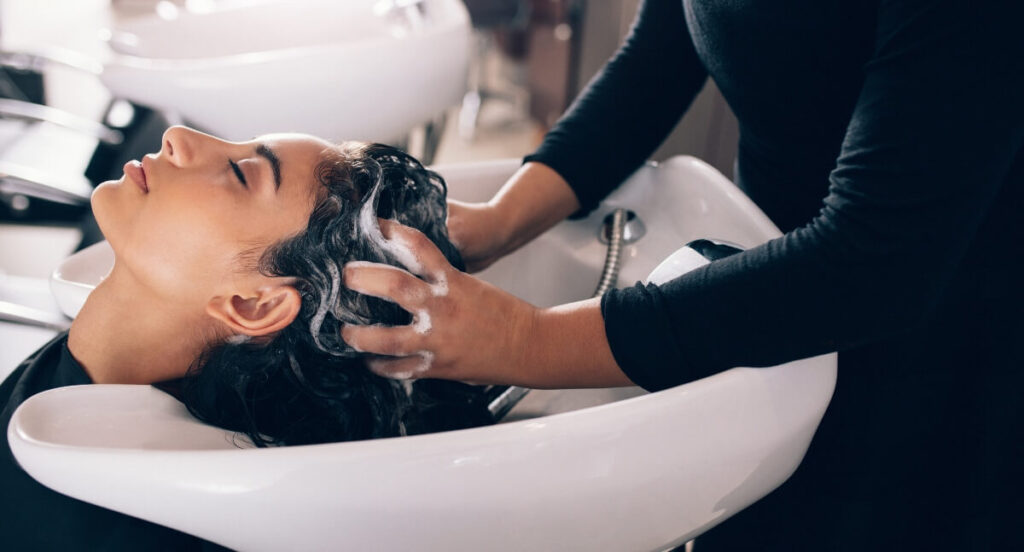
Here’s a little secret your stylist might not know: that discounted $40 shampoo might contain just as many suspect ingredients as that $5 store brand.
The truth about “professional-grade” ingredients is that it’s really just a marketing term. The FDA doesn’t regulate what qualifies as “professional grade,” and there is no standard industry definition of what the term means. Something that’s only sold in salons can contain the exact same sulfates, parabens, and synthetic fragrances that something sold in a grocery store does.
What the salon products do better is the concentration and quality of beneficial ingredients. They can have greater oils, greater conditioning agents, or superior delivery systems. But they’re not necessarily offend-free.
I’ve seen $60 salon shampoos that still label sodium lauryl sulfate as a second ingredient. I’ve seen drugstore brands priced under $10 that are completely sulfate and paraben-free. Price and sales channel don’t always translate to safety or quality.
This is how to evaluate salon referrals critically: have your stylist pull out the list of ingredients and inform you why they’re recommending that specific product for your hair. A good stylist should be able to inform you what a key ingredient does and why they’re applying it to your hair type.
Watch out for stylists who cannot explain to you the advantage of ingredients other than generic marketing phrase like “it’s professional grade” or “it’s what we use in the salon.” This usually means that they’re more focused on selling you something than on what is best for your hair.
The cost-benefit analysis of professional products really comes down to product and your hair needs. Some salon products are completely worth the cost because they use high-end ingredients and formulations. Others are high-priced versions of formulas you can find elsewhere for a fraction of the price.
My advice? Learn to read labels yourself so you can make informed decisions regardless of where a product is sold. Some of the very best clean hair care products I’ve found are at non-specialty stores, while some of the worst culprits I’ve found are in expensive salon products.
Need more advice on caring for your hair in between salon appointments? Societe Salon is the salon you can count on to give you the information you need to achieve the healthy hair you deserve.
Ready to book your appointment?
Decoding Labels Like a Pro: Your Step-by-Step Ingredient Reading Guide
Scanning ingredient panels doesn’t have to be a reading-of-a-foreign-language exercise. It becomes second nature once you recognize what to scan for and where to scan for it.
The INCI Name Decoder
Ingredients are named in their International Nomenclature of Cosmetic Ingredients (INCI) terminology, which are usually the Latin or scientific terminology rather than trade names. Which is why water is an “aqua” and you’ll see “sodium chloride” rather than “salt.”
Common ingredient hide-and-seek techniques
Companies know that individuals are getting smarter about avoiding certain ingredients, so they might employ unfamiliar names or derivatives at times.
- For example, instead of “sodium lauryl sulfate,” you might see “sodium dodecyl sulfate” – the same substance under a different name.
- Parabens can be hidden under such titles as “Alkyl parahydroxybenzoates” or precise chemical names like “4-hydroxybenzoic acid.” Formaldehyde-releasers can be titled as “DMDM hydantoin,” “imidazolidinyl urea,” or “quaternium-15.”
Free tools and resources for instant ingredient checking:
The Think Dirty app allows you to scan the barcodes of products and receive ingredient safety ratings in an instant. The EWG Skin Deep database is another great resource where you can search for specific ingredients or products to look at safety issues and scientific studies.
Yuka is another popular app that rates products on ingredient safety. They are not infallible, but they are super helpful when you are standing in the store comparing brands.
The secret is noticing the first 5-7 ingredients of any product since these make up the majority of the formula. Ingredients are listed in order of decreasing concentration, meaning that if sulfates show up in the first 5, they’re a great majority of that shampoo.
Marketing Claims vs. Reality
- “Natural” is not legally defined for cosmetics, so a product containing one plant extract can call itself natural when the other 20 ingredients are synthetic. “Organic” is slightly better regulated but only for some ingredients, not the entire product.
- “Sulfate-free” does not always mean gentle. Some sulfate-free shampoos use other stripping surfactants that are just as harsh. Always check what they’re using instead of sulfates.
- Greenwashing red flags to watch out for: Be wary of brands that use lots of nature imagery and green packaging but aren’t actually putting their ingredients front and center. Cleaner brands are usually proud to present their ingredient lists and explain the role of each ingredient.
Be wary of words such as “chemical-free” (everything is composed of chemicals, including water) or “toxin-free” with no details on which toxins they’re skipping. These are empty marketing claims.
Seek out specific certifications such as USDA Organic, Leaping Bunny (cruelty-free), or EWG Verified. These involve third-party verification and have strict criteria that brands need to adhere to.
The Clean Beauty Hall of Fame: Ingredients That Actually Nourish Your Hair
Now for the good news – there are plenty of ingredients that can actually clean your hair while improving its health in the long term.
Gentle Cleansing Champions
Sodium Cocoyl Isethionate is derived from coconut oil and is one of the gentlest surfactants available. It creates a rich, creamy lather without stripping the hair of its own oils. Unlike sulfates, it does not lead to protein loss, which is what leads to hair damage in the long term.
Coco-Glucoside and Decyl Glucoside are sugar-derived surfactants that are extremely gentle yet effective at removing dirt and oil. They are completely biodegradable and very rarely irritate, making them perfect for sensitive scalps.
Natural cleansers like shikakai (soap pod) and soapnuts have been used for centuries to clean hair. Shikakai is particularly beneficial as it naturally has a low pH, which will result in smooth and shiny hair cuticles.
Clay cleansers work in a different way to traditional surfactants. Bentonite clay and rhassoul clay can absorb excess oil and impurities without foaming. They’re ideal for people with very oily hair who want to extend the time between washes.
Nourishing Natural Actives
Protein alternatives to harsh chemicals include:
- Hydrolyzed quinoa protein
- Silk protein
- Keratin from sheep’s wool
These proteins can temporarily repair damaged hair cuticle gaps, which smooths and strengthens your hair.
The key with proteins is size – they need to be small enough to get into your hair shaft but not so small that they make your hair feel stiff. Hydrolyzed proteins have been broken down to a perfect size to be absorbed by hair.
Good oils and molecular weights
Not all oils are created equal for the care of your hair.
- Coconut oil has a small enough molecular structure to actually penetrate the hair shaft and condition internally. Argan oil has enough vitamin E and essential fatty acids to restore environmental stressor damage.
- Jojoba oil isn’t really an oil – it’s a liquid wax that’s very similar to the sebum from your scalp. That means it’s excellent for balancing oil production and won’t leave your hair with a greasy feeling.
- Plant extracts with proven benefits: Aloe vera contains amino acids and vitamins that can soothe inflamed scalps and add moisture to dry hair. Green tea extract contains antioxidants that can protect your hair from environmental stress.
- Chamomile extract can naturally lighten hair and add shine, and rosemary extract has been proven in studies to be as effective as minoxidil in promoting hair growth.
Smart Conditioning Agents
is a crucial distinction that confuses many people. Fatty alcohols like cetyl alcohol, stearyl alcohol, and cetearyl alcohol are actually beneficial for your hair. They are natural in origin and are utilized as emollients and conditioning agents.
These alcohols both smooth your hair cuticles and add moisture, which is the opposite of how drying alcohols work. They are waxy at room temperature, which is how you differentiate them from the liquid drying alcohols.
Natural humectants and emollients: Glycerin is a humectant that is capable of drawing moisture from the air into your hair, but must be used with caution. In extremely dry climates, it has the reverse effect and can draw moisture out of your hair.
Panthenol (pro-vitamin B5) is an emollient and humectant that penetrates the hair shaft and provides long-lasting moisture. Sodium PCA is a natural moisturizing factor that enables your hair to hold moisture.
pH-balancing ingredients: Your hair’s natural pH is slightly acidic, ranging from 4.5-5.5. Ingredients like citric acid and lactic acid can provide this optimum pH, which makes your hair cuticles smooth and frizz-free.
Making the Switch: Your 30-Day Transition Plan to Cleaner Hair Care
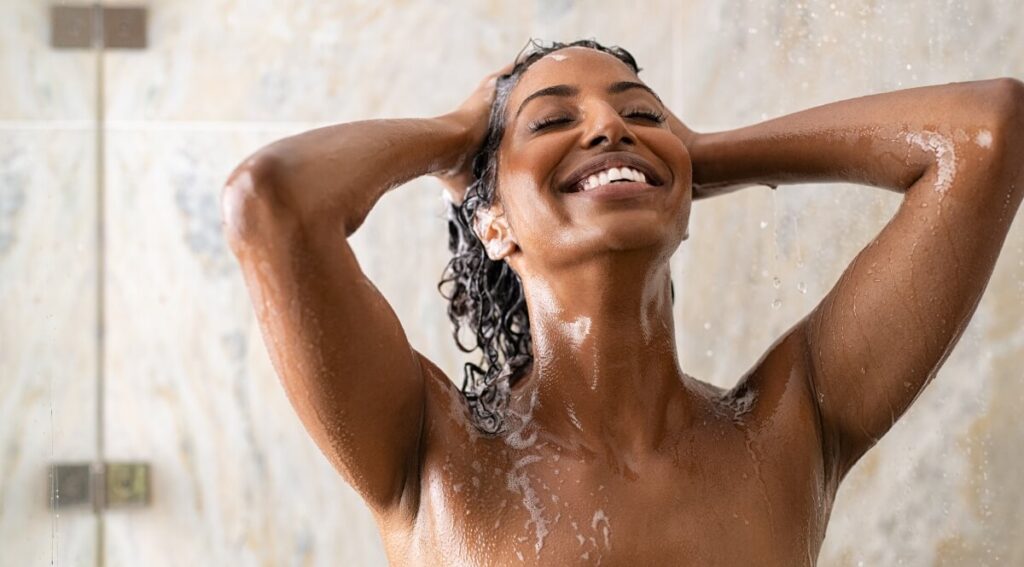
The move to cleaner hair care is not one you need to make overnight. In fact, going slower will lead to more successful results and less stress for your hair and scalp.
Week 1-2: The Detox Phase
What to expect when stripping chemical buildup: If you have been using products with silicones, sulfates, and other buildup-causing ingredients, your hair might actually feel worse before it will feel better. This is completely normal and not long-lasting.
Your hair can be dry, tangled, or look limp during the first week. This is due to the fact that you are removing new layers of coating that have been disguising the state of your hair. It is nearly like removing old paint – you must get rid of the old layers before you can see what you are working with.
Clarify treatments and transition symptoms: Start with a mild clarifying treatment to remove buildup. Either use a homemade apple cider vinegar rinse (1 part vinegar to 3 parts water) or look for a sulfate-free clarifying shampoo.
Don’t be tempted to go back to your old products during this time. Your hair is essentially detoxing, and it does take a bit of time to adjust to functioning without artificial coatings and harsh detergents.
Some people experience more greasiness during this time while their scalp adjusts to not being stripped daily. Some find their hair is tanglier or rougher. The symptoms typically fade within 2-3 weeks.
Weeks 3-4: Finding Your New Regimen
How to determine what works for your hair: By week 3, you should be able to see your hair’s true texture and condition. This is where you can start experimenting with different clean products to find what works best.
Observe the way your hair feels when wet, how it behaves when you’re styling it, and how it is and feels by the end of a day. Jot things down if needed – it’s easy to recall what did work and what didn’t when you’re applying a multitude of products.
Shifting frequency and product: You might discover you can wash your hair less frequently with gentler products. A good many people discover they can wash their hair another day or two without damaging it and actually have healthier hair.
Or you might find that very mild, sulfate-free shampoos just don’t appear to be cleaning your hair well enough. In this case, see if you can find a slightly stronger (but still gentle) surfactants or alternating between a daily mild shampoo and a more powerful cleanser once a week.
Remember that it might take you a few months to discover your perfect routine, not 30 days. Don’t rush the process, and don’t be afraid to adjust as you go along.
Budget-Friendly Clean Beauty: Impressive Products at Every Price Point
Clean beauty doesn’t have to break the bank. There are excellent products at all price points if you know what to look for.
Drugstore bargains under $10: Some of the best clean hair care bargains can be found at common drugstores and grocery stores. Shop for brands like Acure, Alba Botanica, and Yes To, who offer sulfate and paraben-free options for under $10.
Most mass brands have jumped on the bandwagon and now offer “clean” lines within their mass product line. L’Oreal’s EverPure line, Garnier’s Whole Blends, and Herbal Essences’ bio:renew line all offer sulfate-free formulas at drugstore prices.
The trick is to read labels and not believe ad copy. A $6 bottle with clean ingredients will do better than a $30 bottle with parabens and sulfates.
Mid-range ($10-30): This category provides the quality and value sweet spot for most. These products include SheaMoisture, Maui Moisture, and Carol’s Daughter that offer salon-quality formula with clean ingredients.
Most health food stores carry excellent mid-range items like Andalou Naturals, Desert Essence, and Jason that focus on plant extracts and steer clear of common irritants.
Splurges: Every now and then it’s worth the additional dollars for the professional treatments or products with highly innovative formulas. Luxury product lines like Briogeo, Moroccanoil, and Olaplex offer treatments that can truly transform the condition of the hair.
The secret is understanding when to spend and when to save. Splurge on treatments and leave-in conditioners that remain on your hair, but you do not necessarily have to spend $40 on shampoo that will be rinsed out instantly.
DIY treatments for someone with a limited budget
If money is not available, good hair treatments can be produced using products of the kitchen. Coconut oil and honey can be used to make a deep conditioning treatment. Apple cider vinegar is an excellent clarifying rinse.
The aloe vera gel from the plant itself can serve as a light styling gel, and cooled green tea is a great antioxidant hair rinse. These homemade remedies aren’t just inexpensive – they are often more effective than commercial versions because they have no fillers and potentially irritating components.
DIY Hair Care: Simple Recipes Using Kitchen Ingredients
Making your own hair care products means you have control over what you’re placing on your hair, and it’s usually cheaper than purchasing store-bought products.
Simple cleansing recipes:
To make a mild homemade shampoo, blend 1/4 cup liquid castile soap with 1/4 cup coconut milk and 1 teaspoon of honey. This produces a rich, moisturizing cleanser that won’t dry out your hair.
For greasy tresses, try a clay shampoo by mixing 2 tablespoons of bentonite clay with enough apple cider vinegar to create a paste. This will absorb excess oil without drying out.
Deep conditioning treatments:
The simplest and most effective DIY deep conditioner is coconut oil. Heat it slightly, put it on damp hair, and keep it on for 30 minutes to overnight. This is fabulous for dry, damaged, or chemically treated hair.
For protein-sensitive hair, apply a moisturizing mask of 1 ripe avocado, 2 tablespoons honey, and 1 tablespoon olive oil. This provides rich moisture with no protein that agitates some hair to stiffness.
Scalp-soothing solutions:
In case of an itchy or inflamed scalp, apply a soothing rinse of cooled green tea or chamomile tea. Both hold anti-inflammatory properties that calm the irritation.
Aloe vera gel applied directly on the scalp can provide immediate flaking and itching relief. Apply pure aloe vera gel with no fragrance or color added to it.
Precautions with homemade preparations:
Test the new homemade preparation on a small section of hair and scalp before applying it all over. Natural does not always mean non-irritating.
Care with acidic ingredients such as lemon juice or vinegar, which can bleach your hair or damage it if used too often or in too high a concentration. Always dilute these ingredients and use them sparingly.
Refrigerate DIY products and use them within a week, since they do not have preservatives and can spoil quickly.
Going Beyond Shampoo: Steer Clear of Toxic Ingredients in Your Entire Hair Care Regimen
Your shampoo is just a part of your overall hair care routine, and nasty ingredients can be lurking in all of your products.
Conditioners and Treatment Masks
Conditioners and treatment masks often contain a lot of the same unhealthy ingredients as shampoos, with some added problems. Heavy silicones are particularly common in conditioners, where they create the illusion of healthy-looking hair but actually prevent moisture and nutrients from reaching the hair.
Look for conditioners with natural oils, fatty alcohols, and plant conditioning agents instead of synthetic silicones and sulfates.
Styling Products and Heat Protectors
Styling products and heat protectors can be some of the worst offenders for toxic ingredients because they are designed to sit on your hair. They may contain high levels of alcohol, artificial fragrance, and even formaldehyde-releasing preservatives.
Heat protectants will typically contain silicones, which isn’t necessarily a bad thing when they’re water-soluble silicones that won’t build up. Opt for natural heat-protective ingredients in products like shea butter or argan oil.
Hair Accessories and Tools
Hair accessories and tools will often seem like they’re not possible to have bad ingredients, but some hair ties actually contain latex or other allergens. Hair accessories composed of metal can contain nickel, an allergen that’s common.
Choose hair ties made from natural fiber like silk or cotton, and find metal accessories without nickel if you have sensitive skin.
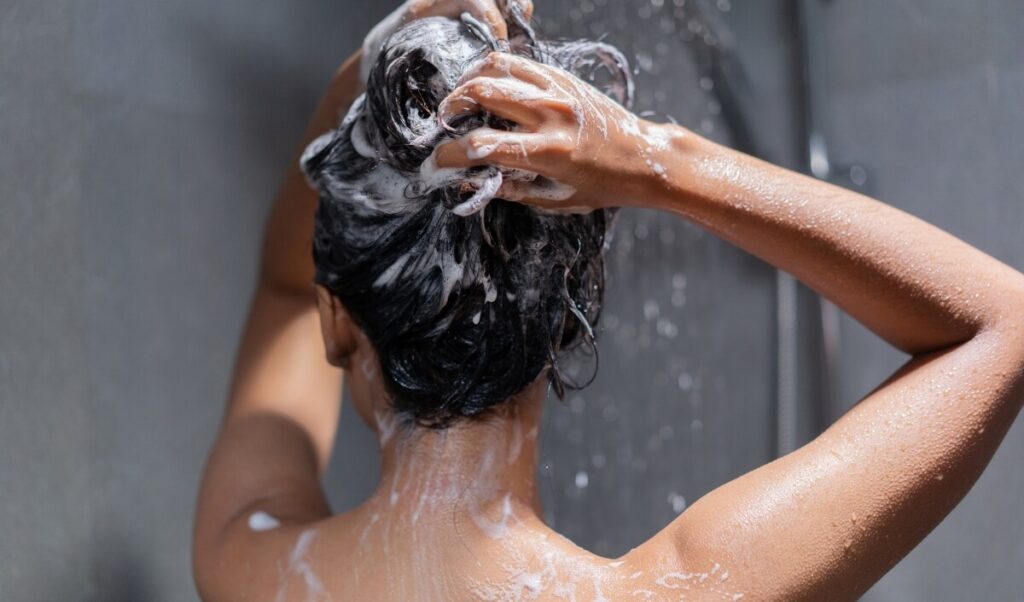
Your Action Plan for Healthier Hair Begins Now
The journey to healthier hair is not one of sudden overnight changes or costly product overhauls. It starts with knowing what you’re putting on your hair today and making informed choices about what to put in its place.
Your following steps to take immediately: Start out by scanning the ingredient labels on items you already use. Look at which ones contain the most offending ingredients we’ve discussed – sulfates, parabens, perfumes, and drying alcohols.
Begin transitioning by replacing the worst of the worst ingredient profiles first. You don’t need to throw everything out at one time, but when you run out of products, replace them with cleaner alternatives.
Long-term vision for hair health: Remember that healthy hair occurs over time, not suddenly. The changes that you make now will reward you in the long run with healthier, more lustrous, more manageable hair months and years later.
Move your attention to nourishing your hair inside out with healthy diet and outside in with gentle, effective products. Your hair will reward you for this effort, and you’ll likely discover that truly clean products work better than chemically laden material you’ve been using.
The key is to start somewhere. Every time you make a small change, you’re getting closer to healthy hair and a healthy you.
Whether you’re looking for a change or need a trim or touch-up, call Societe Salon today. Our elite stylists have helped thousands of clients get the hair they have been dreaming of.
